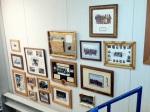Wintering in Antarctica has a long history and a lot of tradition associated with it. The first recorded winter over in Antarctica – that is, below 60° south latitude – was the Belgian Antarctic Expedition of 1897 to 1899 aboard the Belgica. The ship was trapped in the sea ice near Peter I Island, and the multinational crew – which included such famous names as Roald Amundsen, who would eventually lead the first expedition to reach the Geographic South Pole – realized they would have to spend the winter in Antarctica. They were ill equipped for this venture and underwent many hardships; instances of illness and even insanity ensued, with one man ultimately leaving the ship saying he was “going back to Belguim.” It is unclear whether he made it… {<– We need sarcasm font.}
The first deliberate Antarctic winterover expedition on the mainland was the Southern Cross Expedition under the flag of Great Britain. They spent the winter of 1899 at Cape Adare. This was also the expedition that pioneered the use of sled dogs in Antarctica and established a new Farthest South record for the time before the South Pole was reached. Many reports of boredom and unrest from living in cramped quarters came from this expedition as well. (Do we see a pattern emerging?)
This was the Heroic Age of Antarctic Exploration, when nations were racing each other to be the first to do this and that, with the ultimate goal being to conquer 90° south latitude – the South Pole. Roald Amundsen and his party of five were the first to do so on December 14, 1911. However, even though Amundsen went down in history as the first to reach that milestone, Robert Scott’s ill-fated expedition may be just as famous, if not more so. Scott reached the pole only 33 days behind Amundsen, and his entire crew perished on the return journey.
There are books and articles galore that describe this age of exploration, and the impossible feats of endurance and perseverance undertaken by these men. I am not going to attempt to give a full history lesson on all of them; to do them full credit would take much more than one blog post. I merely wish to establish that wintering in Antarctica has an inherent pride associated with it. Though technological advances allow us to pass the dark winter months in a much greater degree of comfort, and we cannot even begin to compare our experiences to what those men suffered through in those days, we still find ourselves in a place of isolation. Even with phones and internet that allow us to communicate with the greenworld, all we have to do is climb to the top of the glacier behind the station and turn around in a circle to know how alone we are. 360° of beautiful views, and not another living soul in sight.
Even though our experience is not as extreme as theirs, we still feel a sense of camaraderie with those early explorers and pride in surviving a winter here.
There are many traditions in Antarctica, things that we try to keep alive year after year. For the winterovers, stations all around the continent, representing many different nations, celebrate the solstice; the Midwinter festivities are a big deal. For people who are typically spending months without any sun – or very short days, in the case of stations like Palmer that are above the Antarctic circle – Midwinter marks the farthest the sun will get away from us before it starts its return journey. It brings whole new meaning to “Here Comes the Sun.” 🙂 It is customary at McMurdo and Scott Base (New Zealand) to jump into the frigid, 28°F water on Midwinter Day for the winterover polar plunge. Most stations also decorate and serve an elaborate feast, many people bring a special outfit for the occasion, and there is often some sort of party afterward. You could say that Midwinter is the one truly Antarctic holiday; a holiday that has grown to mean something special to a mishmash culture of transients, explorers, vagabonds, and untethered souls.
One tradition that seems rather insignificant, but is actually somewhat meaningful, is the winterover photo. Typically, the summer population sees much more coming and going, and less continuity in the residents; thus it is not common for a picture of the entire summer crew to be taken, at least not at the U.S. bases. However, winter is the skeleton crew. For McMurdo, the planes leave at the beginning of March and don’t come back until late August. Here at Palmer, our period of isolation is not so long, but still the boat was supposed to leave us in June (though it was delayed until July 2) and will not return until mid-September. At each station, we are cut off from the rest of the world, stuck with the same group of people – for better or for worse – until the boats or planes return to claim us. It is meaningful for us, that we passed the months together, and so we always commemorate it with a photo.
Walking up the back stairwell of the GWR building (where I live), one is confronted by walls lined with photographs of past winterover crews here at Palmer. Starting in 1965, almost every single crew to pass the winter months here has hung a framed snapshot of their season. A couple do not feature actual photographs – perhaps they didn’t have the equipment that season? – but they still hung something; they still left a piece of themselves behind.
-

-
The earliest winterover crew photos © cheater_tree
-

-
Predominantly 80’s winterover crews © cheater_tree
-

-
Winterover crews of the 90’s © cheater_tree
-

-
The latest batch of winterover photos © cheater_tree
Everybody sees these, and perhaps pause once in a while to look a little closer at one or two photos, but for the most part they have become commonplace and people pass them by without a second glance as they go about their days. I have become fascinated by these photos. These men and women were the people that came before me, who hung their pictures up on this wall as a testament that says, “We were here, we are the history of this place.”

1966: One of the first winterover crews at Palmer to share their group photo © cheater_tree

1966: Back then they still had sled dogs – Eddie appeared to possibly have mange © cheater_tree

1970: Another of my favorites – fish eye view © cheater_tree

1971: They must not have had a camera that year, except for the penguin © cheater_tree

1972: Very high school-esque, right down to the clarinet © cheater_tree

1974: Looks like the landed a plane here that year © cheater_tree

1975: Was this guy a falconer? © cheater_tree

1977: This guy can teach you how to become a Communications Coordinator in only 10 days! © cheater_tree

1978: The first winterover krill? I would like to know the story behind that one © cheater_tree

1980: This guy always catches my eye for some reason © cheater_tree

1981: Guns, rainbow kites, ziplines, and sandals on an iceberg? © cheater_tree

1985: Probably my favorite – check out the job titles © cheater_tree

1987: Sausage fest in a hot tub… okay. © cheater_tree

1990: Climbing the glacier © cheater_tree

1991: Stormy situation © cheater_tree

1999: What was going on with these guys? © cheater_tree
I, too, will be a face on that wall before the winter is over. After this season, I will be taking a break from the program for a while. It is entirely possible – I would even say probable – that I will return to Antarctica in the future; but really, who knows? Who knows what could happen, what could change, or where I could end up? Maybe another great opportunity will come my way and I will never feel the pull to come back to this continent. Maybe I will return, but I will go to one of the other stations or into the deep field. Who’s to say that I will ever see Palmer Station again? Maybe I will, maybe I won’t.
Because of that, I take a strange sense of comfort knowing that I will have a place on this wall amongst all the other winterovers who have come before me and who will come after. Maybe most people won’t ever notice me or my face, or even the entire crew that I spent these months with; maybe we will be stuck in a corner, or have an uninspired photo composition, and nobody will ever look twice. Maybe. But maybe somebody, like me, will find themselves drawn to these pictures, many years down the road, and wonder who these people were and what their stories were.
I will be a part of this station’s history, for any who care to study it.









































